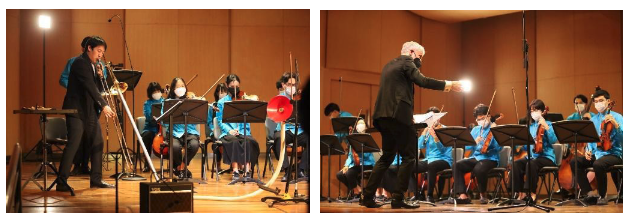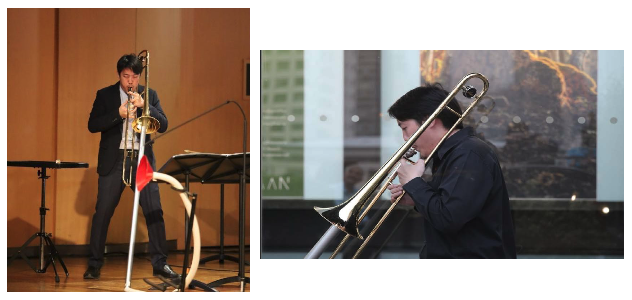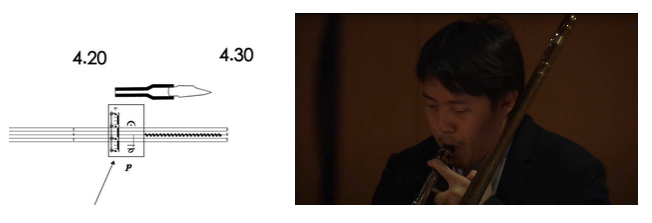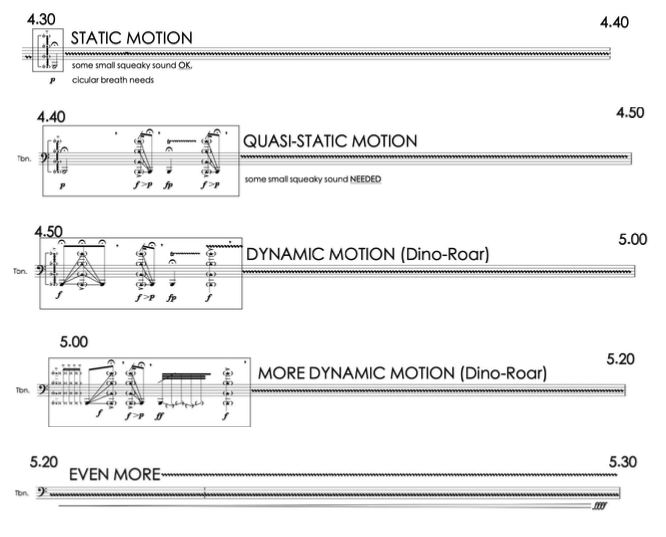PULSE VOL.3 (January 2023)
Growling, Cooing & Rumbling with Dino-Bone The Domination of dinosaur’s vocalization beyond performer’s expectation
- Siravith Kongbandalsuk
Abstract
Dino (2022) for “Dino-Bone,” 3 percussions and prepared strings by Piyawat Louilarpprasert is work scored for a combination of extended acoustic instruments that aims to recreate and reimagine the vocality of dinosaurs through acoustic instrument. “Dino-Bone” is an extended instrument comprised of a metal pipe and plastic tube attached to a trombone with a total length of 1.5 meters. The mouthpiece of the trombone is replaced and alternates between bassoon reed and saxophone mouthpiece. Due to the methodology which reforms the mechanism of a trombone – the acoustic of the instrument is being augmented and enabled to create a series of complex spectrums, timbres, and several frequencies that are not possible on a regular trombone.
This paper discusses: 1) The sonic possibilities that were discovered (both expectedly and unexpectedly) during the rehearsal and performance of Dino (2022). 2) A compositional analysis and interpretation remarks from the performer, with a focus on how the sound of dinosaurs were recreated and reanimated through compositional notations and the use of this extended instrument.
Furthermore, this paper also explores more broadly possibilities of recreating the sound of both living and extinct animals with acoustic instruments.
Introduction of the instrument: construction and sonic result
Dino-Bone is an innovative and experimental amplified trombone created by Piyawat Louilarpprasert for his composition Dino (2022) (see figure 1 & 2). The instrument is designed to produce a wide range of sonorities by means of metal pipe and plastic tube extensions for amplification and alternate sound-generating devices, including the bassoon reed and various saxophone mouthpieces. The instrument’s amplified sound is activated through the extensions, which allow for the exploration of new timbral possibilities. (see figure 3 & 4)

Figure 1 - 2: Recording session of Dino (2022) composed by Piyawat Louilarpprasert, performed by Princess Galyani Vadhana Institute of Music Youth Orchestra with Peter Veale, conductor
The unusual sonic possibilities offered by the alternate sound generators in Dino-Bone include high single tones produced by playing with a tight embouchure and lower pitches with buzzy crow sounds created by loosening the embouchure, similar to the sound of playing a bassoon reed. The sonic effects of various sizes of saxophone mouthpieces (soprano, alto, tenor, and baritone) and trombone (small and large bore) are explored through this work. The combination of an alto saxophone mouthpiece and small bore trombone enables the player to produce compressed, low, buzzing and growling sounds and also to shift to high, squeaky, and buzzy sounds simultaneously by adjusting the oral cavity and position of the embouchure. The latter is is the preferred sound of the composer (Louilarpprasert). Additionally, playing with a saxophone mouthpiece offers a larger dynamic range compared to playing with a bassoon reed. For example, shallow playing creates very soft, compressed sounds, while deep playing creates louder and projected sounds, along with unexpected squeaky sounds and shifted high pitches.

Figure 3 - 4: Dino-Bone – amplified trombone with an extension of metal pipe and plastic tube with alternate mouthpieces of bassoon reed and saxophone mouthpiece as a sound generator
Visualize the sound of Dino-Bone:
For this study, spectral analysis was employed to investigate the sounds produced by the Dino-Bone. The aim was to understand and differentiate the sonic characteristics of Dino-Bone from those of an ordinary trombone. The spectral analysis of the ordinary trombone (see figure 5) is based on the fundamental of the overtone series, whereas the spectral analysis of Dino-Bone reveales a distinct deviation from the overtone series observed in the ordinary trombone.
Two forms of sound were observed when Dino-Bone was played with a bassoon reed. The spectrogram analysis showed that the entire spectrum of the sound produced covered frequencies ranging from below 10Hz to 7,000 Hz, with a single tone relying on frequencies between 600 Hz and 1,200 Hz. The distorted and clustered sound, on the other hand, was characterized by a group of frequencies ranging from 600 Hz to 1,200 Hz, with a nearly equal amplitude (see figure 6). This resulted in a complex frequencies and made it difficult to discern the upper pitches of the overtone series. A different form of sound was observed when Dino-Bone was played with a saxophone mouthpiece. The spectrogram analysis revealed two distinct forms of sound. The first form was characterized by a low buzzing sound, which covered a wide range of frequencies from below 10Hz to 7,000 Hz without an obvious outstanding exact frequency. The second form was a squeak sound, which
covered a frequency range between 1,000 Hz and 2,000 Hz and exhibited a higher amplitude compared to the low buzzing sound (see figure 7).

Figure 5: Spectrogram of trombone playing middle C pitch

Figure 6: Spectrogram of Dino-Bone playing with bassoon reed

Figure 7: Spectrogram of Dino-Bone playing with alto saxophone mouthpiece
Compositional of Dino (2022) and performing analysis of Dino-Bone techniques
In the solo part of Dino (2022), the entire 16 scenes demonstrate the unique
sound of the Dino-Bone and showcase its versatility in both solo and ensemble contexts.
Scene 1 - 8: Dino-Bone (bassoon reed playing) with the orchestra
Scene 9 - 10: Dino-Bone (saxophone mouthpiece playing) Cadenza
Scene 11 - 12: Orchestra only
Scene 13 - 16: Dino-Bone (saxophone mouthpiece playing) with the orchestra
In scenes 1 to 8, Louilarpprasert utilized the bassoon reed (see figure 8) to imitate the roaring characteristics of dinosaurs and convey a progression from slow to medium to fast pacing. He begins this section with a single tone and then becomes multiphonic. However, I as a player decided to interpret it in the opposite way. I decided to present the unique multiphonic sound at the beginning then changed the timbre at the end of the opening section as a cue for the orchestra. With the progression from slow to medium to fast pacing, Louilarpprasert gives a lot of latitude to the performer through his notation. For instance, in the slow section, he notates a variety of timbre and sound gestures with sustain notes such as fermata and longer note values (see figure 9) while medium and fast pacing, he writes shorter notes (8th note and 16th note) as well as description such as, “short, repeating/improvise and have some rest between sound and building up the energy” (see figure 10 & 11). Although there are some similarities in the musical notations between these three sections, to differentiate them further in my playing, I played the slow paced section with slow glissandos while I played the medium and fast-paced sections with medium and medium-fast glissandos and slide tremolos. In addition, I played rhythmicly together with short fragments and repetitions of materials in order to build up energy. These choices are consistent with the indications of the composer.

Figure 8: 0.00 - 0.20 minutes from Dino (2022) Roar/approaching

Figure 8: 0.00 - 0.20 minutes from Dino (2022) Roar/approaching

Figure 10: 0.40 – 1.20 minutes from Dino (2022) – medium pace

Figure 11: 3.00 – 3.50 minutes from Dino (2022) – fast pace
The following sections (scene 9 – 10) represents another sound made by the Dino-Bone, this time through the use of a saxophone mouthpiece. These scenes were written in cadenza form precisely to showcase the uniqueness of sound and sonic transformations on this instrument (see figure 12 & 13).

Figure 12 - 13: From Dino (2022) – notation and performing picture with saxophone mouthpiece
In this cadenza section (scene 9), Louilapprasert indicates five characteristics in the solo part: static motion, quasi-static motion, dynamic motion, more dynamic motion, and even more. These five characteristics were indicated with different musical notation, for instance, the static motion was notated with sustain notes (half notes) and soft dynamics while quasi-static motion contains faster notes (16th notes) and louder dynamics. The further systems of Dino-Roar, dynamic motion, more dynamic motion, and even more, use the same materials as previous systems with addition of faster notes (16th and 32nd notes) as well as rhythmic figures, glissandi, and articulated playing. Louilarpprasert indicates that in all these sections the squeaky sound must be used according to the performer’s judgement of the characteristics of each system (see figure 14 - 18). With this open notation, I interpreted these sections by providing slow glissandi and few squeaky sounds in static and quasi static motion, then I increased the speed of glissandi and added more fast rhythmic motives as well as squeaky sounds in order to transition into the increased dynamic motion of the angry dino-roar in the next section.

Figure 14 - 18: 4.30 - 5.30 minute of Dino (2022) - static motion, quasi-static motion, dynamic motion, more dynamic motion, and even more.
With the indication of “angry dinosaur” the orchestra responds to the solo cadenza in the following scenes (scene 13 – 16). At this point, the soloist is instructed to play with fast and rapid glissandi using 32nd notes and to match the sound of the solo instrument to that of the orchestra, which includes extended sounds of prepared strings and percussion (see figure 19). In this section, the same sound materials from the cadenza section are used with increasingly loud dynamics, faster rhythmic motives, and more rapid slide movements. This is the most enraged part of the entire work. At the end, Louilarpprasert writes long sustained sound with decreasing of dynamics as well as the description, “try to make high frequency from the low fundamental as much as possible, sharpy, squeaky, and itchy” (see figure 20). The performer interpreted this ending with fading sound of Dino-Bone together with lethargic glissandi, very soft dynamics and fewer squeaking sounds.

Figure 19: 7.10 – 7.50 minutes from Dino (2022)

Figure 20: 9.30 till ending from Dino (2022)
Performing analysis and interpretation
Due to its open and indeterminate notation, performing on Dino-Bone requires improvisational skills, particularly with respect to texture and gesture.. This instrument provides a unique and challenging musical experience for performers. Unlike traditional instruments, the Dino-Bone places a greater emphasis on timbre preference and the gestural aspects of sound production rather than exact pitch recognition. This is due to the deviation of the sound produced by the Dino-Bone compared to the traditional overtone and harmonic series of the un-extended trombone. The placement of the bassoon reed in the cup of the trombone and the attachment of the saxophone mouthpiece both cause instability in sound production. This instability, which contains both predictable and unpredictable aspects, requires a high degree of improvisational skill, adaptability, and multi-instrumental skill, including proficiency in playing the bassoon reed, saxophone mouthpiece, and slide trombone. Overall, the Dino-Bone instrument offers a distinct and unconventional musical experience for those who seek to explore new forms of musical expression.
In conclusion, when performing on Dino-Bone, sound materials, timbre, and gesture are important elements to consider. Due to the complexity and instability of these elements, it is necessary to organize and execute them at a certain level in order to improvise and allocate the proportion, duration, temporal division, and characteristics of the sound materials accurately. This will ensure that the performer’s musical interpretation and the composer’s desired outcome match.
Further discussion: Aspect of sonic possibilities and performative function through extraordinary instruments.
The Dino-Bone instrument was created specifically with the purpose of reimagining the acoustic experience of dinosaur vocalizations. However, the instrument has its own unique sound that can be interpreted and utilized in other ways. There is great potential within the Dino-Bone instrument. Future performers may wish to expand its performative capabilities and increase the diversity of sonic possibilities it can produce. This can be accomplished through two complementary avenues of inquiry. The first approach involves utilizing the discipline of paleo-acoustics to investigate and re-imagine dinosaur vocalizations, resulting in a more accurate representation of these sounds. The second approach involves exploring the unique sound and performance techniques of the instrument, including experimenting with extended playing methods and modifications to its size and resonant properties. Both approaches are focused on uncovering previously undiscovered sonic potentialities and enhancing the instrument’s performance capabilities.
References
Borish, Niko, and Caroline Lee. “What Did Dinosaurs Sound like?” Carnegie Museum of Natural History, July 16, 2021. https://carnegiemnh.org/what-did- dinosaurs-sound-like-paleoacoustics/.
Eliason, Chad. “Dinosaurs Didn’t Roar. They Cooed, According to Scientists | CBC Radio.” CBCnews. CBC/Radio Canada, July 15, 2016. https://www. cbc.ca/radio/asithappens/as-it-happens-thursday-edition-1.3679117/ dinosaurs-didn-t-roar-they-cooed-according-to-scientists-1.3679130.
Gallois, Pascal. The Techniques of Bassoon Playing = Die Spieltechnik Des Fagotts = La Technique Du Basson. Kassel: Bärenreiter, 2009.
James J. S. Johnson, J.D., Th.D. 2015. Sound Science about Dinosaurs. Acts & Facts. 44 (1). Kachur, Torah. “Grr! Honk! Research Offers Clues about What Dinosaurs Sounded like | CBC News.” CBCnews. CBC/Radio Canada, October 17, 2016. https:// www.cbc.ca/news/science/dinosaur-sounds-honk-growl-torah-kachur-1.3803212.
Louilarpprasert, Piyawat. Dino for Dino-bone, 3 Percussions and Prepared Strings, 2022
Padian, K. and Ostrom, . John H.. “dinosaur.” Encyclopedia Britannica, April 19,2021. https://www.britannica.com/animal/dinosaur.
Phil Senter (2008) Voices of the past: a review of Paleozoic and Mesozoic animal sounds, Historical Biology, 20:4, 255-287, DOI: 10.1080/08912960903033327
SOLIS, Gabriel, Bruno NETTL, and Sabine Feisst. “John Cage and Improvisation: an Unresolved Relationship.” Essay. In Musical Improvisation Art, Education, and Society, 38–51. Chicago: University of Chicago Press, 2010.
Sullivan, Becky. “Jurassic Bark: How Sound Design Changed Our Imaginations.” NPR. NPR, April 13, 2013. https://www.npr.org/2013/04/13/177153801/
jurassic-bark-how-sound-design-changed-our-imaginations.
Svoboda, Michael, Michel Roth, Jon Roskilly, Christiana Nobach, Vinko Globokar, Michael Svoboda, and Michael Svoboda. The Techniques of Trombone Playing =
Die Spieltechnik Der Posaune. Kassel: Bärenreiter, 2017.
Veale, Peter, cond. Dino for Dino-bone, 3 Percussions and Prepared Strings, by Piyawat Louilarpprasert. Princess Galyani Vadhana Institute of Music Youth Orchestra. Recorded April 10, 2022. Streaming video. https://www.youtube.com/watch?v=rUkbnDqpfdc Weiss, Marcus, Giorgio Netti, Marcus Weiss, and Marcus Weiss. The Techniques of
Saxophone Playing = Die Spieltechnik Des Saxophons. Kassel: Bärenreiter- Verlag Karl Vötterle GmbH & Co. KG, 2015.